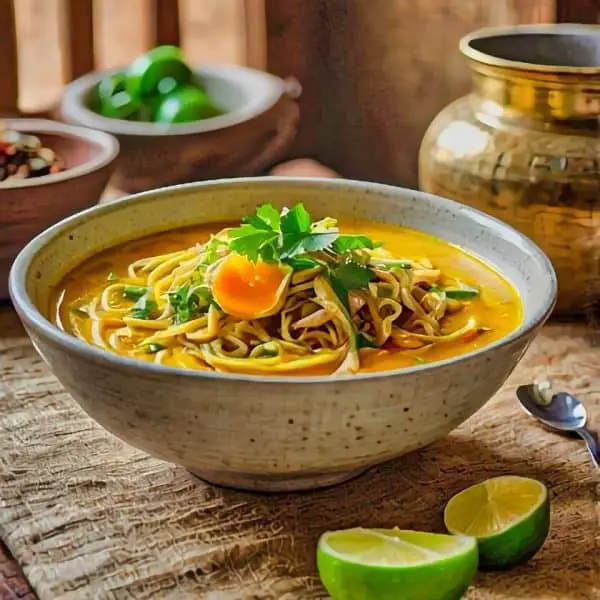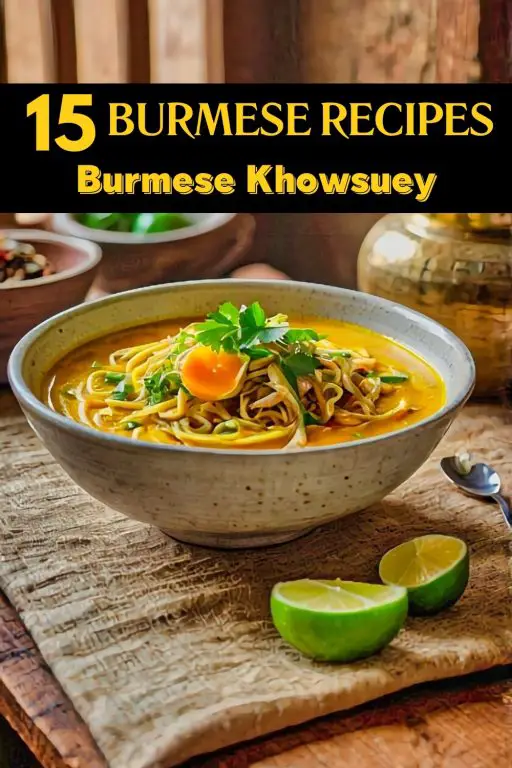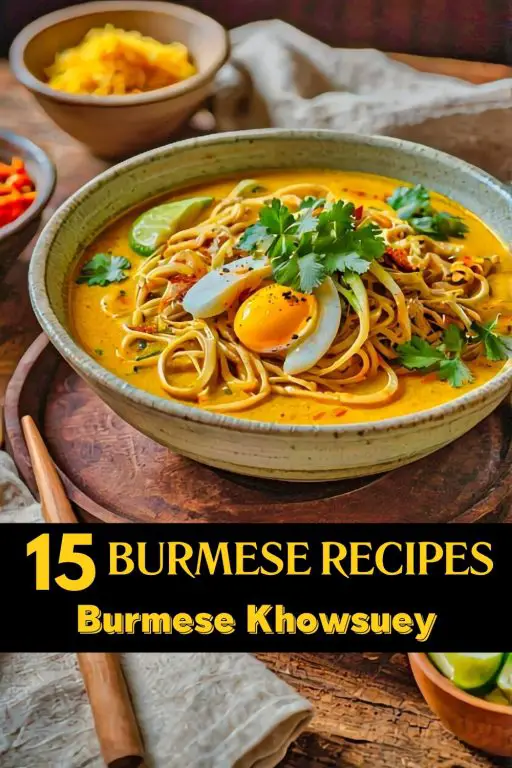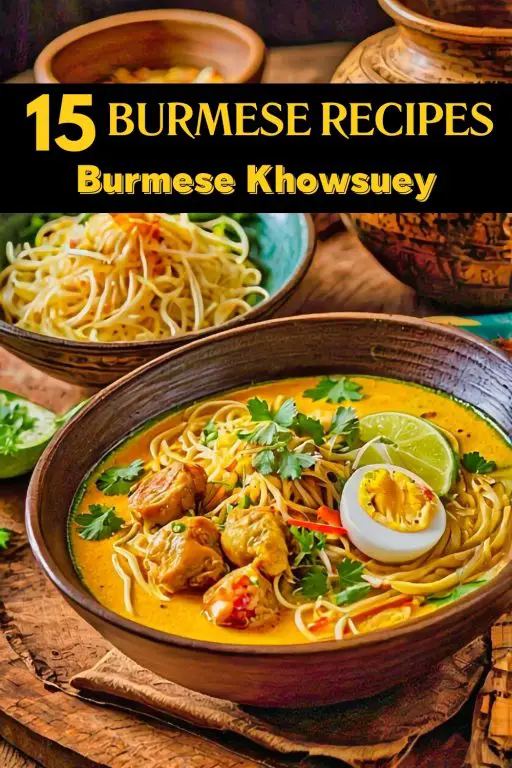I learned how to make Burmese Khowsuey when I stayed with a host family in Bagan. The recipe for Burmese Khowsuey is a noodle soup with a rich stock made from curry. This dish is known for having a lot of different tastes and textures that work well together. While we were cooking, I learned that the Burmese Khowsuey recipe is also often eaten for its health benefits.
Turmeric is often used in the soup base because it is known to reduce inflammation. This makes the Burmese Khowsuey recipe not only tasty, but also good for your health and stomach. Besides that, the food usually has a lot of different vegetables, which can be easily changed to make it healthier. For example, adding more legumes or green leafy veggies can make the dish higher in fiber and vitamins.
One interesting thing about the Burmese Khowsuey recipe is that it can be changed to fit different health needs. You can make it healthier by using whole grain noodles or cutting back on the coconut milk. This will lower the number of calories and fat in the dish. Working with my host family to cook gave me useful ideas on how to make these kinds of changes while still keeping the main idea of the traditional recipe.
After preparing the Burmese Khowsuey recipe, I received the recipe to try at home. This experience helped me appreciate how traditional recipes can be adapted for better health without sacrificing taste.
Ingredients For the Khowsuey Recipe
For the Curry
Boneless Chicken Thighs or Beef Cut Into Bite-sized Pieces
Coconut Milk
Chicken or Beef Broth
Finely Chopped Onions
Minced Garlic Cloves
Peeled and Grated Fresh Ginger
Turmeric
Chili Powder
Fish Sauce
Salt
Pepper
Vegetable Oil
For the Toppings
Dried Egg Noodles
Bean Sprouts
Chopped Scallions
Chopped Cilantro
Chopped Peanuts
Limes Cut Into Wedges
Chili Flakes or Hot Sauce
Cooking Instructions For the Khowsuey Recipe
- In a large pot, heat the vegetable oil over medium-high heat. Add the onions, garlic, and ginger and sauté until fragrant, about 2-3 minutes.
- Add the chicken or beef to the pot and cook until browned on all sides.
- Add the turmeric, chili powder, salt, and pepper, and stir to coat the meat evenly.
- Pour in the coconut milk and broth and bring to a boil. Reduce the heat to low and let simmer for 20-30 minutes or until the meat is tender.
- Add the fish sauce to the pot and stir to combine.
- Cook the egg noodles according to package instructions.
- To serve, place a portion of noodles in a bowl and ladle the curry over the noodles.
- Top the curry with bean sprouts, scallions, cilantro, and chopped peanuts. Squeeze a wedge of lime over the top and sprinkle with chili flakes or hot sauce if desired.
5 Essiential Ingredients for Cooking Burmese Style Food
1. Rice
Description: Rice is the fundamental staple of Burmese cuisine, reflecting its status as a primary food source across Myanmar. It is typically long-grain or jasmine rice, known for its slightly sticky texture when cooked.
Usage: Rice accompanies nearly every meal, serving as the base for curries, soups, and salads. It is essential in dishes like Mohinga, where it is sometimes added directly to the soup or served on the side. In addition to steamed rice, fried rice variations are also popular, often including vegetables, meats, and sometimes even seafood. Rice is versatile, used in both everyday meals and festive dishes.
2. Fish Sauce (Ngan Pya Yay)
Description: Fish sauce is a fermented condiment made from fish and salt. It has a pungent aroma but imparts a deep umami flavour that is crucial to many Burmese dishes. It is usually made from anchovies or other small fish and aged to develop its robust taste.
Usage: Fish sauce is used extensively to season soups, curries, and salads. In dishes like Laphet (fermented tea leaf salad), it adds a salty depth that balances the tangy and bitter notes of the tea leaves. It is also a key ingredient in many dipping sauces and marinades, contributing to the complex flavour profiles typical of Burmese cuisine.
3. Lemongrass
Description: Lemongrass is a fragrant herb with a citrusy, slightly floral flavour. Its stalks are used in cooking, providing a bright, fresh aroma and taste. In Burmese cuisine, it is used both for its flavour and for its fragrant qualities.
Usage: Lemongrass is commonly added to broths and soups, such as Mohinga, to impart a distinctive lemony taste. It is also used in marinades for meat and fish, and in curries to enhance the overall flavour profile. Lemongrass is typically cut into pieces or bruised to release its essential oils, infusing dishes with its aromatic essence.
4. Ginger
Description: Ginger is a spicy, aromatic root widely used in Burmese cooking. It adds warmth and depth to dishes, with a flavour that is both sharp and sweet. Fresh ginger is preferred, though dried or powdered ginger is also used in some recipes.
Usage: Fresh ginger is often combined with garlic to form a flavour base for many Burmese dishes. It is used in curries, soups like Kaukswe (coconut noodle soup), and stir-fries. Ginger’s warming spice complements the complex flavours of Burmese cuisine, balancing out richer elements and enhancing the overall taste.
5. Turmeric
Description: Turmeric is a bright yellow spice known for its earthy, slightly bitter flavour and vibrant colour. It contains curcumin, which is responsible for its distinctive hue and is celebrated for its health benefits.
Usage: Turmeric is integral in many Burmese curries and stews, where it imparts a rich golden colour and an earthy flavour. It is often used in combination with other spices to create the complex flavour profiles typical of Burmese curries. Turmeric is also used in rice dishes and some soups to add both colour and flavour. Its presence is key to achieving the characteristic appearance and taste of traditional Burmese dishes.
Each of these ingredients plays a crucial role in defining the unique flavours of Burmese cuisine, contributing to the rich and varied taste experiences that characterise Myanmar’s culinary traditions.
Most Popular Spices For Burmese Cooking
Burmese cuisine is renowned for its rich, complex flavours, achieved through the use of a diverse array of spices that form the backbone of its culinary tradition. One of the most essential spices in Burmese cooking is turmeric, prized for its vibrant yellow colour and earthy flavour. Turmeric is frequently used in curries and stews, imparting both a warm, robust taste and a distinctive golden hue to dishes. Another crucial spice is cumin, which adds a nutty, slightly smoky flavour that enhances the depth of curries and spice blends. Cumin seeds are often toasted to release their essential oils, making them even more aromatic and flavourful.
Ginger is another indispensable spice in Burmese kitchens, valued for its fresh, zesty heat. It is used both as a fresh root and in powdered form, often combined with garlic to create a base for many dishes, including the beloved Mohinga (fish noodle soup). Garlic itself is a cornerstone of Burmese cuisine, providing a pungent, savoury depth that complements a wide range of dishes from stir-fries to curries.
Chili peppers are crucial for adding heat and complexity to Burmese food. Whether used fresh, dried, or in powdered form, chilis are integral to many dishes, contributing varying levels of spiciness. The use of chili powder or chili flakes allows cooks to adjust the heat level according to personal preference, balancing the spicy kick with other flavours in dishes like Shan Noodles and various curries.
Coriander seeds also play a significant role in Burmese cooking, offering a citrusy, slightly sweet flavour that complements the earthiness of other spices. Coriander is often used in combination with cumin and turmeric to create well-rounded spice blends that define the flavour profiles of many Burmese dishes. Additionally, lemongrass is an aromatic ingredient used to infuse dishes with a fresh, lemony scent, particularly in soups and marinades.
Each of these spices contributes to the distinctive taste of Burmese cuisine, showcasing the intricate balance of flavours that characterises the food of Myanmar. Through their careful use, Burmese cooks create dishes that are not only flavorful but also deeply rooted in the country’s culinary traditions.
FAQ For the Khowsuey Recipe
Q: What ingredients are essential for a traditional Burmese Khowsuey recipe?
A: A traditional Burmese Khowsuey recipe requires egg noodles, coconut milk, and a mix of spices including turmeric, cumin, and coriander. The curry base typically includes garlic, ginger, and onions for depth of flavor. The dish is often topped with garnishes like fried onions, boiled eggs, and fresh cilantro. These components come together to create a rich, aromatic meal with distinct layers of flavor.
Q: How can I adjust the spiciness in a Burmese Khowsuey recipe?
A: To adjust the spiciness in a Burmese Khowsuey recipe, modify the amount of chili powder or fresh chilies used in the curry base. For a milder dish, reduce the amount of chili or use a milder chili variety. If you prefer more heat, add extra chili or include spicy condiments like chili oil when serving. Balancing the spices with coconut milk can help manage the overall heat level.
Q: Can I use a slow cooker for a Burmese Khowsuey recipe?
A: Yes, a Burmese Khowsuey recipe can be adapted for a slow cooker. Simply combine the curry ingredients, including coconut milk, spices, and protein, in the slow cooker and cook on low for 6-8 hours or on high for 4-5 hours. The slow cooking method allows the flavors to meld beautifully, and the noodles can be cooked separately and added just before serving. This method is convenient for preparing a flavorful, hands-off meal.
Q: What are some common garnishes for a Burmese Khowsuey recipe?
A: Common garnishes for a Burmese Khowsuey recipe include crispy fried onions, chopped fresh cilantro, and boiled eggs. Additional toppings like lime wedges, chili flakes, and fresh green chilies can enhance the dish. Some recipes also suggest adding pickled vegetables or roasted peanuts for extra texture and flavor. These garnishes not only add visual appeal but also enhance the overall taste of the dish.
Q: How can I make a Burmese Khowsuey recipe gluten-free?
A: To make a Burmese Khowsuey recipe gluten-free, use rice noodles instead of egg noodles and ensure all sauces and pastes are gluten-free. Substitute soy sauce with a gluten-free alternative like tamari if needed. Check labels for any hidden gluten in ingredients such as curry pastes or seasonings. By making these adjustments, you can enjoy a delicious and safe version of this classic dish.

Burmese Khowsuey
Equipment
- Large pot for cooking the curry
- Medium pot for boiling noodles
- Cutting board and Sharp knife
- Measuring cups and spoons
- Wooden spoon or spatula
- Bowls for serving
Ingredients
For the Curry:
- 2 lbs. boneless chicken thighs or beef cut into bite-sized pieces
- 4 cups coconut milk
- 4 cups chicken or beef broth
- 2 onions, finely chopped
- 4 garlic cloves, minced
- 2 inches of fresh ginger, peeled and grated
- 2 tsp turmeric
- 2 tsp chili powder
- 2 tbsp fish sauce
- 2 Salt and pepper to taste
- 2 tbsp vegetable oil
For the Toppings:
- 1 package dried egg noodles
- 2 cups bean sprouts
- ½ cup chopped scallions
- ½ cup chopped cilantro
- ½ cup chopped peanuts
- 2 limes, cut into wedges
- Chili flakes or hot sauce (optional)
Instructions
- In a large pot, heat the vegetable oil over medium-high heat. Add the onions, garlic, and ginger and sauté until fragrant, about 2-3 minutes.
- Add the chicken or beef to the pot and cook until browned on all sides.
- Add the turmeric, chili powder, salt, and pepper, and stir to coat the meat evenly.
- Pour in the coconut milk and broth and bring to a boil. Reduce the heat to low and let simmer for 20-30 minutes or until the meat is tender.
- Add the fish sauce to the pot and stir to combine.
- Cook the egg noodles according to package instructions.
- To serve, place a portion of noodles in a bowl and ladle the curry over the noodles.
- Top the curry with bean sprouts, scallions, cilantro, and chopped peanuts. Squeeze a wedge of lime over the top and sprinkle with chili flakes or hot sauce if desired.





4 comments
This Burmese Khowsuey recipe has quickly become a favorite in our household.
I disagree with the use of coconut milk in the Khowsuey recipe. Its too overpowering and takes away from the traditional flavors. I prefer using a mix of chicken broth and evaporated milk for a lighter taste.
I believe adding a dash of coconut milk to the Burmese Khowsuey recipe would take it to the next level! Whos with me on this creamy twist? Lets spice things up in the kitchen! 🌶🥥
I cant believe they didnt include the option to add extra spice to the Khowsuey recipe! Some of us like it hot, you know. 🌶️ #SpiceUpYourLife
Comments are closed.